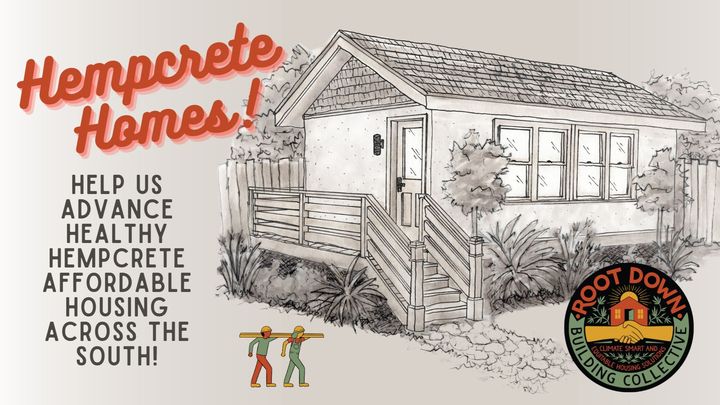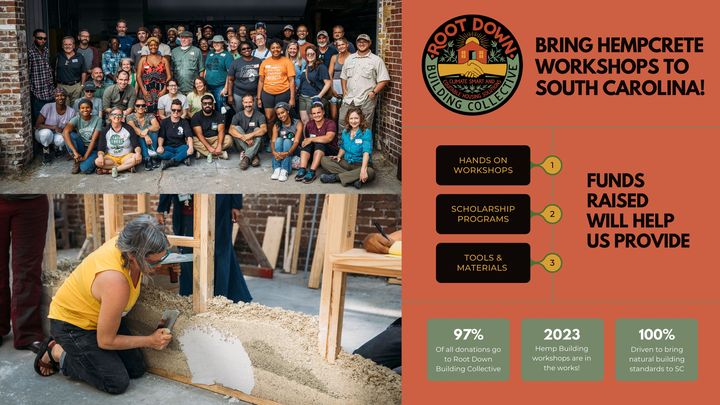Organized by Root Down Building Collective

Help Advance Healthy Hempcrete Affordable Housing!
Help us advance Healthy Hempcrete Affordable Housing by supporting our first pilot project, THE CHARLESTON HEALTHY HOUSING PROJECT!!!
Over a year of dedicated work has led to RDBC receiving a building permit from Charleston County to construct a 350SF studio utilizing a panelized hempcrete system! This project serves as a crucial proof-of-concept and will act as a research and data collection component to analyze data concerning the environmental performance of the panelized hempcrete insulation system being developed. This Phase 1 project is necessary for our Phase 2 approach to scalable healthy housing solutions for our most vulnerable communities across the southern and coastal environments located at the epi-center of climate-related catastrophes.

Hempcrete/Hemp-lime is an innovative, bio-fabricated wall system that is well-suited to our humid southern environment. This modular system consists of prefabricated hemp-lime panels and regionally manufactured bio-based building materials. This project will establish a scalable housing solution with positive environmental & human health impacts, customized for our coastal environment (150 mph wind zone). Building workshops, tours, video documentation, and research/data-collection will be incorporated into this project.
We need your help! Any tax-deductible donation amount will help with all of the time and expertise needed to fuel this work. We are applying for grants, but at this time, our young, grassroots organization is operating on a 100% volunteer basis.



Image above: The Nauhaus Project , Asheville, NC
CHARLESTON HEALTHY HOUSING PILOT PROJECT will help provide housing solutions that address:
- Affordable Housing
- Climate-Smart, Bio-Based, Healthy Housing
- Flood & Moisture Resistance / Anti-mold for southern climates
- Regional, Circular Economic Models
- Workforce Development & Community Building
- Modular, Scalable Solutions
- Reduce Greenhouse Emissions
- Enhanced Indoor Air Quality in Disadvantaged Communities
- Research & Data Collection on energy performance, humidity control, indoor air quality, and more
- Regenerative Agriculture + Regenerative Architecture
- New Construction Models
- Prototypes for Modular Home Replacement
View our pitch book here!
Continue reading below for more info......
Help us reach our $10k goal, to help construct THE CHARLESTON HEALTHY HOUSING PILOT PROJECT!!! Your tax-deductible donation of ANY amount shows us that we have your support, and that support will help tremendously! There are a few perks for our biggest supporters. See info below :)
In gratitude,
April Magill
Executive & Founding Director, Root Down Building Collective
PERKS for DONATING!
- $25 or more: Exclusive newsletter with detailed updates on the project status, starting this spring!
- $500 or more: Custom-made rammed earth succulent planter mailed to you.
- $750 or more: Participation in a group tour of the hempcrete structure
$3,000 or more: Custom lime plaster installation using Earthaus Mineral Finishes (limited to 150sf total; Charleston region only, ex: accent wall, small bathroom, kitchen backsplash, etc.)
Read more about this project, and RDBC below….
THE CHARLESTON HEALTHY HOUSING PILOT Project Team:
- Architect: April Magill, Root Down Designs
- Hempcrete Consultant: Tim Callahan, Callahan Homes
- Structural Engineer, structure: John Chase/Medlock Engineers
- Structural Engineer, helical pile foundation: JB Engineering
- Research & Data: Clarke Snell, New York Institute of Technology
- Foundation/Helical Pile Contractor: Construx
- Builders: me and you!
WHAT IS HEMP-LIME (AKA HEMPCRETE)? Hempcrete is a non-structural, sustainable, and moisture/rot-resistant building material that is a viable alternative to traditional insulation. It is a mixture of hemp fibers, lime, and water that creates a lightweight and durable material that can be used to insulate the building envelope. Hempcrete has a variety of benefits, including its ability to store carbon (aka reverse greenhouse emissions), regulate humidity, and its resistance to mold, pests, and fire. In addition, it is a renewable resource that can be grown quickly and sustainably in the Carolinas, making it a highly attractive option for healthier housing projects. Hempcrete is a “carbon-storing” & “climate-smart” building material. Regenerative agriculture + architectural solutions are the answer to a sustainable and resilient future!


HEMPCRETE IN THE BUILDING CODES: In Rochester, NY in April of 2022, the International Code Council (ICC) approved hemp-lime for use in residential construction. The International Residential Code (IRC) Commentary for the Hemp-lime Appendix BA was submitted in June of 2023. Prior to the formal issuance of Appendix BA, all projects utilizing this material are to be stamped by a licensed structural engineer. Appendix BA Hemp-Lime (Hempcrete) Construction will be included in the 2024 IRC
WHY IS THIS IMPORTANT???
CHALLENGES FACING OUR COMMUNITIES:
1. EMISSIONS
The building sector must be carbon-neutral or carbon-negative by 2030! (the climate imperative by the IPCC - Intergovernmental Panel on Climate Change)
In the City of Charleston alone, buildings account for nearly 65% of citywide emissions at 867,200 MtCO2e and remain the largest sector of pollution citywide. The Charleston Climate Action Plan strives to: Reduce emissions 56% below 2018 levels by 2030. Reduce emissions to net zero by 2050.



2. HOUSING INSECURITY
41% of The City of Charleston Plan survey respondents said they are somewhat or very concerned about being able to stay in their current housing. This percentage was more than 10 points higher among Black/African Americans and more than 20 points higher among lower-income respondents, youth, and tenants.
- Charleston County has stated that they will need an estimated 29,000 to 36,000 new units of housing over the coming decade.
- In 40 of 46 counties statewide, the average South Carolina renter cannot afford a basic two-bedroom apartment without overextending their budget.
- There are 72,565 subsidized housing units in South Carolina, only enough to serve 20 percent of low-income renters statewide.
- There are 375,996 mobile homes in South Carolina, which represents 16.5% of the total housing stock in the state, according to the U.S. Census Bureau. Mobile homes provide housing for the most low-income individuals which are nearing the end of their lifespans and will not withstand climate-related weather events.

3. HUMAN HEALTH REPERCUSSIONS & DISPARITIES
Poor indoor air quality due to excessive moisture, mold, and harmful VOCs from building materials is a growing concern. Poor indoor air quality is more prevalent for those living in sub-par housing situations, leading to health problems and creating more disparities for low-income communities.



SOLUTIONS PROVIDED BY RDBC
Climate-smart (or carbon-storing) buildings are the key to a sustainable and resilient future. We can significantly reduce building-related greenhouse emissions not only by addressing “operational energy emissions”, but by also reducing the “upfront emissions” produced during the extraction, manufacturing, and transportation of building materials. With this approach, we create carbon-STORING buildings vs. carbon emitters.
Current data shows us that we must take this approach in order to meet the reduction emission goals of 2030 & 2050. Our Phase 1 approach, THE CHARLESTON HEALTHY HOUSING PILOT PROJECT, will advance these building solutions through an R&D & Education phase. Building workshops will be facilitated during this phase.
More on our community building workshops here!!
In Phase 2, we will implement Phase 1 solutions into a scalable, healthy housing program to build carbon-storing, climate-smart homes, while educating and empowering communities and creating new jobs and skills in the construction industry, with a focus on marginalized demographics. (think Habitat for Humanity meets Hempcrete!) Modular Healthy Homes will provide affordable, scalable housing solutions for our most vulnerable communities who will be the most affected by the repercussions of climate change. Furthermore, these solutions will enhance positive indoor air quality for the inhabitants and provide healthy, dignified living situations for our most marginalized communities. Bio-based building materials are carbon-storing, agricultural products; regenerative agriculture + regenerative architecture is the key to a sustainable and resilient future!
Help us reach our $10k goal, to help construct THE CHARLESTON HEALTHY HOUSING PILOT PROJECT!!! Your tax-deductible donation of ANY amount shows us that we have your support, and that will help tremendously!
More details in our PITCH BOOK here!!
Thank you!
April Magill
Executive & Founding Director, Root Down Building Collective
PERKS for DONATING!
$25 or more: Exclusive newsletter with detailed updates on the project status, starting this spring!
$500 or more: Custom-made rammed earth succulent planter mailed to you.
$750 or more: Participation in a group tour of the hempcrete structure
$3,000 or more: Custom lime plaster installation using Earthaus Mineral Finishes (limited to 150sf total; Charleston region only, ex: accent wall, small bathroom, kitchen backsplash, etc.)

custom made rammed earth succulent holder

Earthaus lime-plastered wall
Bio's of the Team
April Magill

Tim Callahan

Clarke Snell is an architect and an Associate Professor of Architecture at New York Institute of Technology. His professional and academic focus is to develop and apply sustainable and resilient building systems toward a zero resource architecture. He splits his efforts between (1) applying research into low-tech, high performance materials, assemblies, and systems to the design and construction of small buildings and their micro-climates; and (2) developing architectural workflows that allow performance modeling and simulation to inform form making. He has written several books and numerous articles on related topics. In academia, he has taught a variety of studios and core courses in both architecture and engineering and has conducted research that covers a wide range of topics from developing and testing low-tech low-carbon building envelopes, to investigations in high performance low-carbon material science, to methodologies for teaching sustainable design. His design/build work with students features two Solar Decathlon competitions including the 2015 winning entry.
- N
- T
- E
32 supporters











